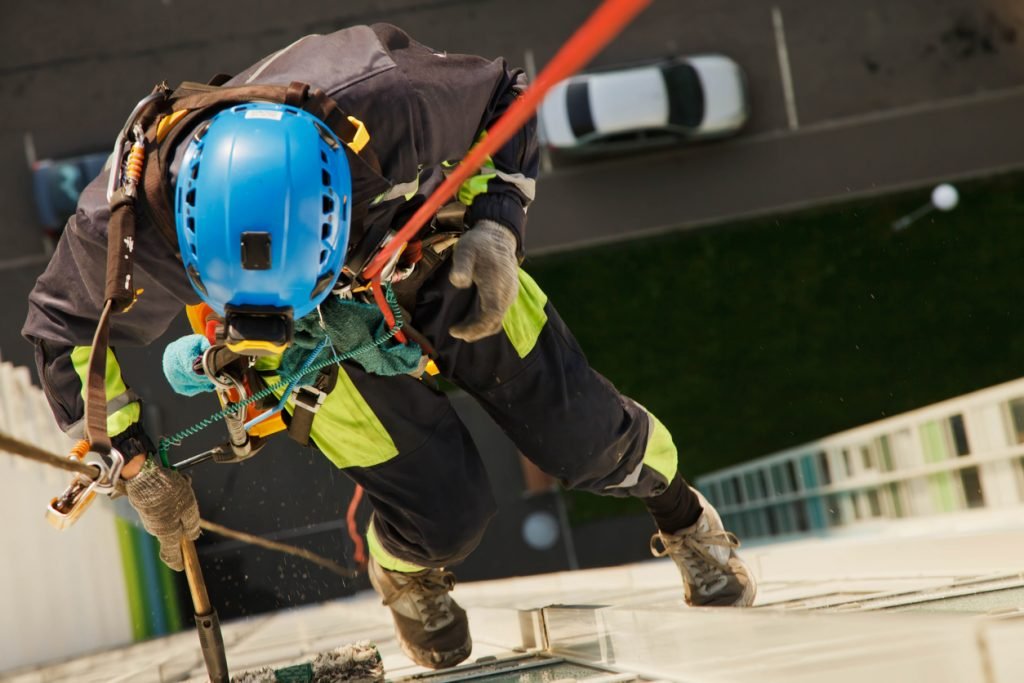Which Working at Height Equipment is Best for My Business?
There are many dangers when working from height; in fact, it’s one of the most dangerous work environments in the UK. So, having the proper fall protection equipment, amongst other safety precautions, is essential for you and your employee’s safety, as well as the protection of your business. But, finding the right equipment for your business may be tricky, especially if you’re looking to implement it for the first time.
Working at height expert using fall arrest system
So, we’re helping you decide which working at height equipment is best for your business by venturing into the different safety equipment we offer and which industries and work environments they work best in. We’re working at height experts here at Altus Safety and are proud to have protected and supported a wide range of businesses, and we can help yours too.
How Do I Know If I Need Working at Height Equipment?
Working at height doesn’t just mean on top of scaffolding, up towers, or on roofs. It means working at any distance where you could fall to a lower level and become injured if the proper precautions are not taken. Let’s take a look at some examples and which industries you may find them in:
Using ladders. You will find ladders in almost all workplace environments, which is why using ladders safely is essential training for nearly everyone. Even using a stool or small step ladder is classed as working at height, so in shops to reach high clothes rails and in offices to get to light bulbs for example.
Working on scaffolding. This doesn’t just include the construction industry; there could be a long list of reasons a staff member needs to access a building’s scaffolding while work is being completed, so it’s essential to implement suitable equipment and training.
Construction workers working on a roof
Operating on a roof. Proper working at height safety equipment is required if any roof maintenance is needed. This must be implemented regardless of whether work is necessary in case of emergencies such as leaks.
Working on unstable surfaces. Industrial work environments such as warehouses, loading bays, and workshops may have unstable surfaces or areas where fixed guard systems cannot be used. In that case, overhead fall protection systems are the appropriate choice.
In some cases, just one of our working at height solutions is fine. However, if you’re unsure and feel as though your business would benefit from (or needs) multiple solutions, we’re here to help.
Edge Protection
An edge protection system is best implemented outdoors on roofs and walkways on the edges of a building. They are implemented to act as a barrier between yourself and a potential fall, and there are a few variations depending on your needs and the structure:
Freestanding Handrails and Guardrails. This type of edge protection is suitable for most roofs and doesn’t require drilling.
Collapsible Handrails and Guardrails. These are perfect if you’re looking for a space-saving option as they can fold down when not in use, becoming almost entirely invisible from ground level.
Fixed Guardrails. These can be secured to most materials such as standing seam, composite, concrete, single ply, and brick.
Clamp Handrails. This type of edge protection allows for flexible installation due to its unique adjustable clamp design.
Altus Safety worker using an overhead fall arrest system
Ladders
As mentioned, ladders are found in a long list of work environments, but the following workplaces require more than a step ladder or stool:
Companionway ladders are most commonly found in warehouses as all the space is often utilised, including the hard to reach areas.
Property Maintenance. All different types of fall arrest ladders are used in property maintenance so employees can get high up safely inside and outside the building.
Construction Sites. Again, various ladders are used on construction sites, including caged access ladders.
Even though you may not believe it necessary, having the proper training implemented for using ladders (even step ladders) is absolutely necessary and could save lives.
Fall Arrest and Restraint
We offer Mansafe personal fall protection systems on roofs where other collective measures are not possible. These are suitable for an extensive list of business types, including any environment that requires working at height. We understand that each workplace is different and will have different requirements, so as a fall protection designer, you can be guaranteed that we’ll find you a cost-effective, compliant fall arrest system.Not only this, but if you’re unsure which equipment is right for you and your business, we are more than happy to provide a survey and working at height risk assessment that supplies you with your options and gives you the chance to ask our experts any questions. Additionally, our team will design, supply, and install your chosen equipment and inspect and test it when needed. Don’t worry about getting other companies involved and complicating your experience; everything you need is at Altus Safety.



